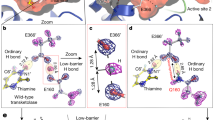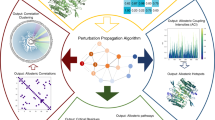Abstract
Enzyme activity is commonly controlled by allostery, where ligand binding at one site alters the activities of distant sites. Classical explanations for multisubunit proteins involve conformational transitions that are fundamentally deterministic. For example, in the Monod-Wyman-Changeaux (MWC) paradigm, conformational transitions occur simultaneously in all subunits. In the Koshland-Nemethy-Filmer (KNF) paradigm, conformational transitions only occur in ligand-bound subunits. In contrast, recent models predict conformational changes that are governed by probabilities rather than absolute rules. To better understand allostery at the molecular level, we applied a recently developed spectroscopic and calorimetric method to the interactions of a dimeric enzyme with two different ligands. We found that conformational transitions appear MWC-like for a ligand that binds at the dimer interface and KNF-like for a distal ligand. These results provide strong experimental support for probabilistic allosteric theory predictions that an enzyme can exhibit a mixture of MWC and KNF character, with the balance partly governed by subunit interface energies.
This is a preview of subscription content, access via your institution
Access options
Subscribe to this journal
Receive 12 print issues and online access
$259.00 per year
only $21.58 per issue
Buy this article
- Purchase on Springer Link
- Instant access to full article PDF
Prices may be subject to local taxes which are calculated during checkout





Similar content being viewed by others
References
Monod, J., Wyman, J. & Changeux, J.P. On the nature of allosteric transitions: a plausible model. J. Mol. Biol. 12, 88–118 (1965).
Koshland, D.E., Nemethy, G. & Filmer, D. Comparison of experimental binding data and theoretical models in proteins containing subunits. Biochemistry 5, 365–385 (1966).
Gill, S.J., Robert, C.H., Coletta, M., Dicera, E. & Brunori, M. Cooperative free-energies for nested allosteric models as applied to human-hemoglobin. Biophys. J. 50, 747–752 (1986).
Daugherty, M.A. et al. Identification of the intermediate allosteric species in human hemoglobin reveals a molecular code for cooperative switching. Proc. Natl. Acad. Sci. USA 88, 1110–1114 (1991).
Yifrach, O. & Horovitz, A. Nested cooperativity in the ATPase activity of the oligomeric chaperonin GroEL. Biochemistry 34, 5303–5308 (1995).
Hilser, V.J. & Thompson, E.B. Intrinsic disorder as a mechanism to optimize allosteric coupling in proteins. Proc. Natl. Acad. Sci. USA 104, 8311–8315 (2007).
Hilser, V.J., Wrabl, J.O. & Motlagh, H.N. Structural and energetic basis of allostery. Annu. Rev. Biophys. 41, 585–609 (2012).
Duke, T.A.J., Le Novere, N. & Bray, D. Conformational spread in a ring of proteins: a stochastic approach to allostery. J. Mol. Biol. 308, 541–553 (2001).
Motlagh, H.N., Wrabl, J.O., Li, J. & Hilser, V.J. The ensemble nature of allostery. Nature 508, 331–339 (2014).
Motlagh, H.N. & Hilser, V.J. Agonism/antagonism switching in allosteric ensembles. Proc. Natl. Acad. Sci. USA 109, 4134–4139 (2012).
Popovych, N., Sun, S.J., Ebright, R.H. & Kalodimos, C.G. Dynamically driven protein allostery. Nat. Struct. Mol. Biol. 13, 831–838 (2006).
Tzeng, S.R. & Kalodimos, C.G. Dynamic activation of an allosteric regulatory protein. Nature 462, 368–372 (2009).
Cooper, A. & Dryden, D.T.F. Allostery without conformational change - a plausible model. Eur. Biophys. J. 11, 103–109 (1984).
Pan, H., Lee, J.C. & Hilser, V.J. Binding sites in Escherichia coli dihydrofolate reductase communicate by modulating the conformational ensemble. Proc. Natl. Acad. Sci. USA 97, 12020–12025 (2000).
Volkman, B.F., Lipson, D., Wemmer, D.E. & Kern, D. Two-state allosteric behavior in a single-domain signaling protein. Science 291, 2429–2433 (2001).
Gunasekaran, K., Ma, B.Y. & Nussinov, R. Is allostery an intrinsic property of all dynamic proteins? Proteins 57, 433–443 (2004).
Freiburger, L.A. et al. Competing allosteric mechanisms modulate substrate binding in a dimeric enzyme. Nat. Struct. Mol. Biol. 18, 288–294 (2011).
Wright, G.D. & Ladak, P. Overexpression and characterization of the chromosomal aminoglycoside 6′-N-acetyltransferase from Enterococcus faecium. Antimicrob. Agents Chemother. 41, 956–960 (1997).
Adler, A.J., Greenfield, N.J. & Fasman, G.D. Circular dichroism and optical rotatory dispersion of proteins and polypeptides. Methods Enzymol. 27, 675–735 (1973).
Saxena, V.P. & Wetlaufer, D.B. A new basis for interpreting circular dichroic spectra of proteins. Proc. Natl. Acad. Sci. USA 68, 969–972 (1971).
Uversky, V.N. Natively unfolded proteins: a point where biology waits for physics. Protein Sci. 11, 739–756 (2002).
Burk, D.L., Ghuman, N., Wybenga-Groot, L.E. & Berghuis, A.M. X-ray structure of the AAC(6 ′)-Ii antibiotic resistance enzyme at 1.8 Å resolution; examination of oligomeric arrangements in GNAT superfamily members. Protein Sci. 12, 426–437 (2003).
Burk, D.L., Xiong, B., Breitbach, C. & Berghuis, A.M. Structures of aminoglycoside acetyltransferase AAC(6 ′)-Ii in a novel crystal form: structural and normal-mode analyses. Acta Crystallogr. D Biol. Crystallogr. 61, 1273–1279 (2005).
Wybenga-Groot, L.E., Draker, K.-a., Wright, G.D. & Berghuis, A.M. Crystal structure of an aminoglycoside 6′-N-acetyltransferase: defining the GCN5-related N-acetyltransferase superfamily fold. Structure 7, 497–507 (1999).
Gao, F., Yan, X.X., Baettig, O.M., Berghuis, A.M. & Auclair, K. Regio- and chemoselective 6′-N-derivatization of aminoglycosides: Bisubstrate inhibitors as probes to study aminoglycoside 6′-N-acetyltransferases. Angew. Chem. Int. Ed. 44, 6859–6862 (2005).
Eftink, M.R., Anusiem, A.C. & Biltonen, R.L. Enthalpy entropy compensation and heat capacity changes for protein ligand interactions: general thermodynamic models and data for the binding of nucleotides to ribonuclease A. Biochemistry 22, 3884–3896 (1983).
Spolar, R.S., Livingstone, J.R. & Record, M.T. Use of liquid-hydrocarbon and amide transfer data to estimate contributions to thermodynamic functions of protein folding from the removal of nonpolar and polar surface from water. Biochemistry 31, 3947–3955 (1992).
Livingstone, J.R., Spolar, R.S. & Record, M.T. Contribution to the thermodynamics of protein folding from the reduction in water-accessible nonpolar surface-area. Biochemistry 30, 4237–4244 (1991).
Norris, A.L. & Serpersu, E.H. Antibiotic selection by the promiscuous aminoglycoside acetyltransferase-(3)-IIIb is thermodynamically achieved through the control of solvent rearrangement. Biochemistry 50, 9309–9317 (2011).
Özen, C., Norris, A.L., Land, M.L., Tjioe, E. & Serpersu, E.H. Detection of specific solvent rearrangement regions of an enzyme: NMR and ITC studies with aminoglycoside phosphotransferase(3′)-IIIa. Biochemistry 47, 40–49 (2008).
Ehlert, F.J. Estimation of the affinities of allosteric ligands using radioligand binding and pharmacological null methods. Mol. Pharmacol. 33, 187–194 (1988).
Wyman, J. On allosteric models. Curr. Top. Cell. Regul. 6, 209–226 (1972).
Freiburger, L.A., Auclair, K. & Mittermaier, A.K. Van't Hoff global analyses of variable temperature isothermal titration calorimetry data. Thermochim. Acta 527, 148–157 (2012).
Freiburger, L.A., Auclair, K. & Mittermaier, A.K. Elucidating protein binding mechanisms by variable-c ITC. ChemBioChem 10, 2871–2873 (2009).
Marley, J., Lu, M. & Bracken, C. A method for efficient isotopic labeling of recombinant proteins. J. Biomol. NMR 20, 71–75 (2001).
Cavanagh, J., Fairbrother, W., Palmer, A. & Skelton, N. Protein NMR spectroscopy principles and practice (Academic Press, Inc., San Diego, 1996).
Kay, L.E., Keifer, P. & Saarinen, T. Pure absorption gradient enhanced heteronuclear single quantum correlation spectroscopy with improved sensitivity. J. Am. Chem. Soc. 114, 10663–10665 (1992).
Acknowledgements
The authors would like to thank G.D. Wright (McMaster University) for providing the AAC(6′)-Ii expression construct. This research was funded by operating grants from the Canadian Institutes of Health Research (CIHR MOP-89784) to K.A. and A.M. L.F. was supported through a CIHR training grant. A.B. holds a Canada Research Chair in Structural Biology. A.B. and A.M. are members of Groupe de Recherche Axé sur la Structure des Protéines (GRASP), which funds the NMR centre where the experiments were performed. NMR experiments were recorded at the Québec–Eastern Canada High Field NMR Facility, supported by McGill University and GRASP.
Author information
Authors and Affiliations
Contributions
A.M., K.A. and A.B. designed the experiments; L.F. collected and analyzed ITC and NMR data; T.M. analyzed NMR data; S.Z. collected and analyzed ITC data; O.B. analyzed X-ray crystallographic data; and A.M and L.F. wrote the paper.
Corresponding author
Ethics declarations
Competing interests
The authors declare no competing financial interests.
Supplementary information
Supplementary Text and Figures
Supplementary Results, Supplementary Tables 1 and 2, Supplementary Notes 1–3 and Supplementary Figures 1–4. (PDF 679 kb)
Rights and permissions
About this article
Cite this article
Freiburger, L., Miletti, T., Zhu, S. et al. Substrate-dependent switching of the allosteric binding mechanism of a dimeric enzyme. Nat Chem Biol 10, 937–942 (2014). https://doi.org/10.1038/nchembio.1626
Received:
Accepted:
Published:
Issue Date:
DOI: https://doi.org/10.1038/nchembio.1626
This article is cited by
-
An isothermal titration calorimetry study of phytate binding to lysozyme
Journal of Thermal Analysis and Calorimetry (2017)



